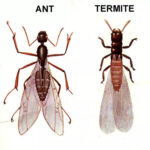 1. Termites don’t just eat wood.
1. Termites don’t just eat wood.
Termites don’t exclusively eat wood. They eat anything that contains cellulose. When termites get into a home, they will eat more than just the wood. There are many other products that have cellulose in them including wallpaper, sheetrock, paper, clothing, cardboard boxes, and more. Sometimes, workers will exit a wall and enter into a pile of clothes or boxes to feed. This can cause widespread damage through these items. If you have items in storage, consider putting them in plastic totes.
2. A queen termite can live more than 20 years.
A termite queen can live more than 20 years. Some estimate this to be as long as 50 years. That means your termite infestation isn’t going to go away anytime soon. In fact, termite infestations grow over time.
3.Termites never sleep.
Termites are simple organisms that do not require sleep. While this may sound like a good thing, it is not. Don’t picture in your mind’s eye sleepless drones that burn themselves out in a couple of weeks. A worker termite can live several years. And, if they couldn’t, those workers can easily be replaced by new workers. A single queen can produce as many as 30,000 eggs in one day! In her lifetime, that’s over a hundred million potential termites produced by one colony.
4.Termite swarms don’t last long.
There are a lot of misconceptions about termite swarmers. One that is probably the least known is that swarms don’t last very long. When termite swarmers exit a colony and take to the air, they only swarm for about 30 minutes. After that, they get busy shedding their wings, mating, and establishing new nests. This is important to understand because it gives insight into what it means when you see termite swarmers crawling on the outside of your home or, worse, crawling around on the inside. Since swarms don’t last long, they don’t travel far. So those swarmers probably came from somewhere on your property or somewhere nearby. That means you have an active and mature colony nearby that has probably already done some damage to your home.
5.Termite workers don’t have functional eyes but they avoid light.
A worker lives its entire life in darkness. It has no need for usable eyes. But it does have simple eyes that can detect light. This sense may not help it get around but it serves it well by helping to prevent a worker from accidentally chewing a hole to the outside and exposing the colony to the drying effects of the sun.
6.Termite swarmers love the light.
Male and female reproductives have the ability to see. They use this ability to find a mate and establish a new colony. And, since their job is to exit the old colony in search of a new place to be, they are drawn to the light. This helps them find their way to the surface and take to the air. Often, this will happen in the early morning when the sun begins to rise.
7.There is more than one kind of termite.
Termites can be broken down into three classifications: subterranean, drywood, and dampwood termites. Of the three, subterranean termites are head and shoulders above the rest in terms of property damage. In the United States, subterranean termite damage costs U.S. property owners billions annually.
8.There are no dead-beat dads in a termite colony.
Winged swarmers are made up of male and female alates. The females will go on to be the queen of a new colony. But she doesn’t begin her new nest alone. The male she decides to mate with becomes the “king” of the colony and stands by his queen. Both of these termites live in the heart of the colony their entire lives. While the role of the king is somewhat mysterious and not fully understood by scientists, it is clear that he has an important role to play.
9.Termites communicate with smells and sounds.
There are many smells that can affect the behavior of termites. As mentioned above, the smell of pathogens during grooming can make termites act defensively. But termites also use smell to communicate with each other. The queen, in particular, produces pheromones (chemicals released from special glands that have a scent to them) to inspire worker termites to develop into soldiers or swarmers. A worker termite releases pheromones from a gland on the underside of its abdomen to mark trails for other workers to find food.
While you’re not likely to ever hear termites, they do make sounds. These sounds are usually subtle and only perceptible if you use something to amplify the sound, such as a stethoscope. In rare cases, when many individual termites are in one location, it is possible to hear them without amplification.
10.Termite workers are the only termites that eat food.
In a colony, there is a queen, a king, larvae, nymphs, male and female reproductives, soldiers, and workers, but only the workers eat food. The rest of the colony get their food through a process called trophallaxis (the mutual exchange of regurgitated liquids between adult social insects or between them and their larvae.)
If you experience an influx of insects around your home, call the experts at Universal Pest Services (610)449-0740 and schedule a free inspection today!